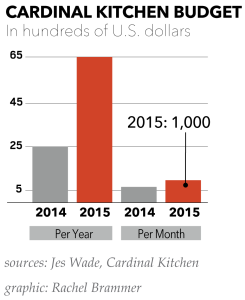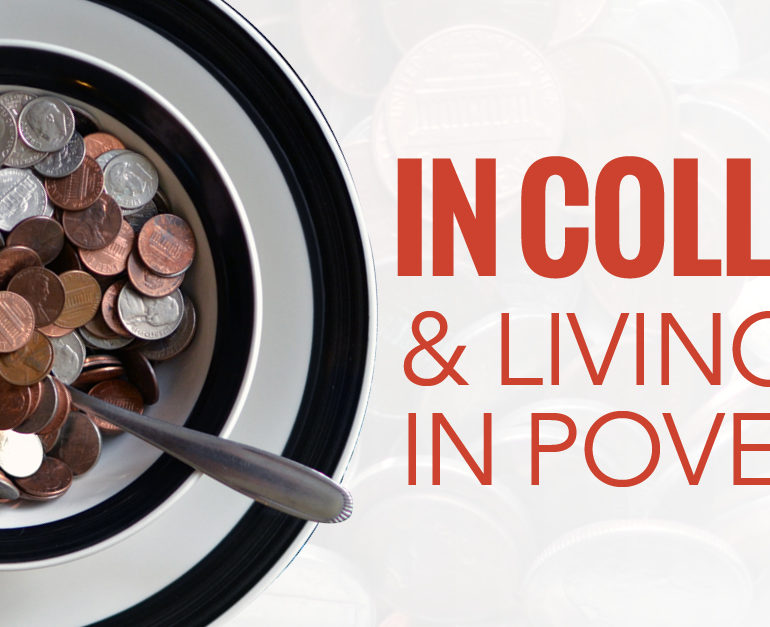On January 7, 2015, senior Jes Wade and a small group of volunteers waited anxiously on the first floor of Ball State University’s Multicultural Center. The weather was below freezing, which added to Jes’s doubt that anyone would take advantage of Cardinal Kitchen, Ball State’s new pantry for students struggling to afford food. Halfway through the final hour, a group of about ten students walked in, including a girl with a huge smile across her face. She marked her wanted items on the food bank’s provided inventory checklist. Jes took the paper and glanced at the student’s request as she walked up a short flight of stairs toward the pantry, a small room on the right side of the hall. She filled a grocery bag with an assortment of foods from the kitchen’s twelve options and returned downstairs. After handing the student her food, Jes wished her a nice day and the girl, still smiling, looked at Jes. “This is better than Christmas,” she said.
Across the United States, an increasing number of college students face the harsh reality that they are food insecure. The United States Department of Agriculture defines food insecurity as inconsistent access to nutritional food due to a lack of money and other resources at times during the year, and until recently the issue has gone largely unnoticed. In 2014, students at Western Oregon University were used as the basis for a study that found 59 percent of the school’s students qualified as being food insecure during the year. Study author Daniel López-Cevallos, an associate director of research at Oregon State University, said in a press release that based on past research he expected to find some amount of food concerns amongst students, but it shocked him to find the issue was so severe.
Two years prior, a similar study was completed at the University of Hawaii at Manoa, where 21 percent of its students were found food insecure, with another 24 percent at risk. Researchers from both studies concluded that food insecurity is an issue of some prevalence, and something that colleges and universities across the nation need to evaluate and address.
While the definitive reason behind college students and food insecurity has not been studied in detail, experts speculate that the steady tuition increases combined with an influx of students from low-income families is playing a prominent role. In the last five years alone, the average rate of tuition and fees at a four-year public school has risen 17 percent, according to The College Board. The percent change does not take into account room and board, which can add roughly another $10,000 to a student’s yearly costs. In comparison, the average costs of tuition, fees, and room and board in four-year public institutions today have risen 150 percent since 1979-80.
The price of college, however, has done little to deter Millennials from pursuing higher education. Enrollment in degree-granting institutions increased by fifteen percent from 1992 to 2002 and another 24 percent the following decade, according to the National Center for Educational Statistics. In June, The Washington Post ran an article based on the Education Department’s latest findings on the Pell Grant program. The federal program, which provides eligible undergraduates with various amounts of financial aid per semester, reported that 75 percent of its 8.6 million recipients had no savings entering college. While the grant does not account for potential family retirement funds, more than half of the students eligible to receive a Pell Grant reported coming from households with income levels of less than $20,000 per year.
Financial advisor Mark Kantrowitz works with families of all income levels and said his goal is to make paying for the “universal good” of a college education easier for students. One option Mark proposed is to triple the amount of aid given to students by the Pell Grant, which has declined by more than 40 percent since the program’s creation in 1972.
“When you have a low-income, you don’t have the luxury of saving money, and so expectations that a low-income student is going to be able to work during the summer to provide a minimum student contribution is ridiculous,” Mark said. “If these students are working, they are working as the primary wage earner for their family. They don’t have the ability to work extra hours to save money for college, because they are struggling to survive just having the basic minimum living expenses. In fact, the formula is stacked against low-income students.”
With many students facing the seemingly insurmountable task of acquiring food on a daily basis, often more than just their bank accounts feel the toll. The exclusion of nutritious food from one’s diet can not only have a negative effect on one’s physical health by increasing the likelihood of sickness and fatigue, but it can also increase the chances of developing a mental health disorder such as anxiety or thoughts of death.
“When someone isn’t getting the right nutrition, they’re not getting enough protein, there is a good possibility their hair might be falling out, their skin is really dry. If they aren’t getting enough vitamins and minerals, their brains may not be functioning the right way,” said Amanda Kruse, a dietitian and nutritionist at Ball State. “You lose your train of thought sometimes when you’re hungry. Imagine not eating for days at a time. Then on top of that you’re anxious, you don’t feel well, you don’t know how you’re going to get food on the table. All of these things correlate back into one’s health.”
 In April 2015, Jes went to the Student Government Association to increase the pantry’s budget. She asked the Student Senate to give Cardinal Kitchen $6,500 per year instead of the current $2,500. “We are spending almost $1,000 a month,” Jes told the assembly. “The current $700 a month budget isn’t enough.” Jes broke down the monthly costs of operating the pantry and shared her plans for fundraising across campus. She had seen the need for a food bank on Ball State’s campus, and she also knew if the budget increase was denied that the pantry would not be around much longer. The new budget was approved at the next meeting.
In April 2015, Jes went to the Student Government Association to increase the pantry’s budget. She asked the Student Senate to give Cardinal Kitchen $6,500 per year instead of the current $2,500. “We are spending almost $1,000 a month,” Jes told the assembly. “The current $700 a month budget isn’t enough.” Jes broke down the monthly costs of operating the pantry and shared her plans for fundraising across campus. She had seen the need for a food bank on Ball State’s campus, and she also knew if the budget increase was denied that the pantry would not be around much longer. The new budget was approved at the next meeting.
College boards and organizations have begun to realize that students need help affording food. The number of college food banks has increased from four in 2008, to 209 as of September 1, 2015, according to the College and University Food Bank Alliance. Feeding America, a network of emergency food agencies, included college students in its “Hunger in America” report for the first time in 2014. Although there is growing awareness surrounding food insecurity, stigmas still exist that can deter students from taking advantage.
“Being food insecure is an issue that can be really uncomfortable to talk about, because I don’t think anyone wants to admit that they can’t provide for themselves,” said Rachel Johnson, the vice president of Ball State’s food pantry. “Especially when you’re entering college, and you’re in the mindset of moving out of your parent’s house and living on your own. It can be uncomfortable to realize that you reach that point where you do need assistance.”
In need of its own assistance, Cardinal Kitchen is finalizing a partnership with Second Harvest, a food bank in East Central Indiana. The partnership will provide Ball State’s food pantry with a support group, as well as the opportunity to purchase its food at a lower price. “How we made it four and a half months I have no idea,” Jes said. “We were very desperate. Lots of student organizations that we had already talked to somehow found it in their hearts to give us more money.”
Despite the stigma, some students know there might not be an alternative for food if they do not walk through the doors of Ball State’s Multicultural Center and mark Cardinal Kitchen’s inventory checklist. They are mostly strangers to Jes, but to them, she is Santa for a day.



